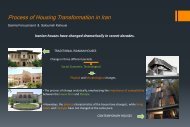Housing Concepts - Oikodomos
Housing Concepts - Oikodomos
Housing Concepts - Oikodomos
Create successful ePaper yourself
Turn your PDF publications into a flip-book with our unique Google optimized e-Paper software.
OIKODOMOS <strong>Housing</strong> <strong>Concepts</strong><br />
HOUSING AMENITIES AND UTILITIES<br />
The level of the housing quality stems from the fulfilment of the basic and<br />
superior living standards within the dwelling unit, as well as the amount of<br />
complementary services, housing utilities and amenities, including health,<br />
education, shopping, working, recreation, etc. The satisfaction of all human<br />
needs and desires represents a very wide range of factors, which must be taken<br />
into account and consequently incorporated in any design of living environment.<br />
The creation of mixed areas with the optimal proportion of residential units,<br />
amenities, working and public spaces facilitates the design of convenient,<br />
pleasant spaces for the largest possible spectrum of users and dwellers. Design<br />
of the residential areas must be considered as a multifunctional unit consisting<br />
of mutually interconnected architectural elements that constitute the cultural<br />
and social milieu. They must cover all standard needs of the individual and<br />
community expressive of its way of life.<br />
Hence the terms “housing amenities” and “utilities” represent a very important<br />
part of architectural and urban planning design.<br />
In the architectural context it implies the items of everyday usage, which<br />
increase the standard of living. <strong>Housing</strong> utilities are all the things that are<br />
necessary in order to live. Water, electricity, heating, air conditioning,<br />
kitchen equipment, furniture, balconies, terraces, garage, parking lots, etc.,<br />
are what most people consider utilities when looking for a place to live. Some<br />
items can be considered as „luxury“ because they aren‘t necessary for living,<br />
such as cable TV, satellite, the Internet and telephone. They influence the<br />
quality of housing.<br />
In the urban context it applies mainly for the structure of amenities of a city<br />
and the community in order to design specific areas for shops, services, offices,<br />
leisure, health and education facilities and culture. It also includes the<br />
quality of design of semi-private and public spaces.<br />
<strong>Housing</strong> amenities and utilities on the architectural scale<br />
(student project)<br />
When it comes to home<br />
features, prospective<br />
dwellers consider ample<br />
garage space, walk-in<br />
closets, open-plan<br />
design, walk-in shower,<br />
master bathroom with<br />
dual vanities and<br />
separate tub and<br />
shower, energyefficient<br />
systems,<br />
including HVAC/furnace,<br />
appliances, and highperformance<br />
windows.<br />
Considered is the<br />
locality within the<br />
city, the proximity to<br />
community amenities<br />
such as mass transit,<br />
major highways,<br />
employment corridors,<br />
schools, walking/biking<br />
paths, playgrounds,<br />
sports and<br />
entertainments<br />
facilities.






